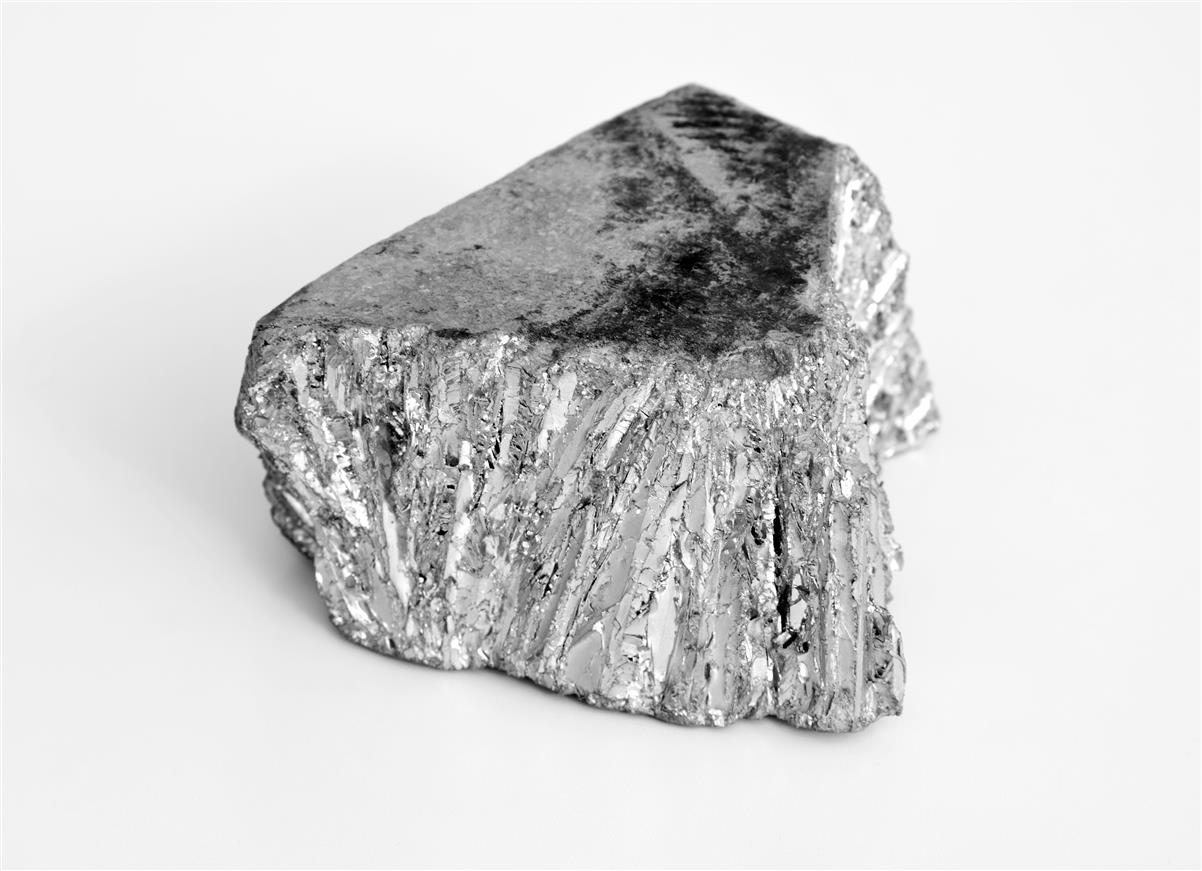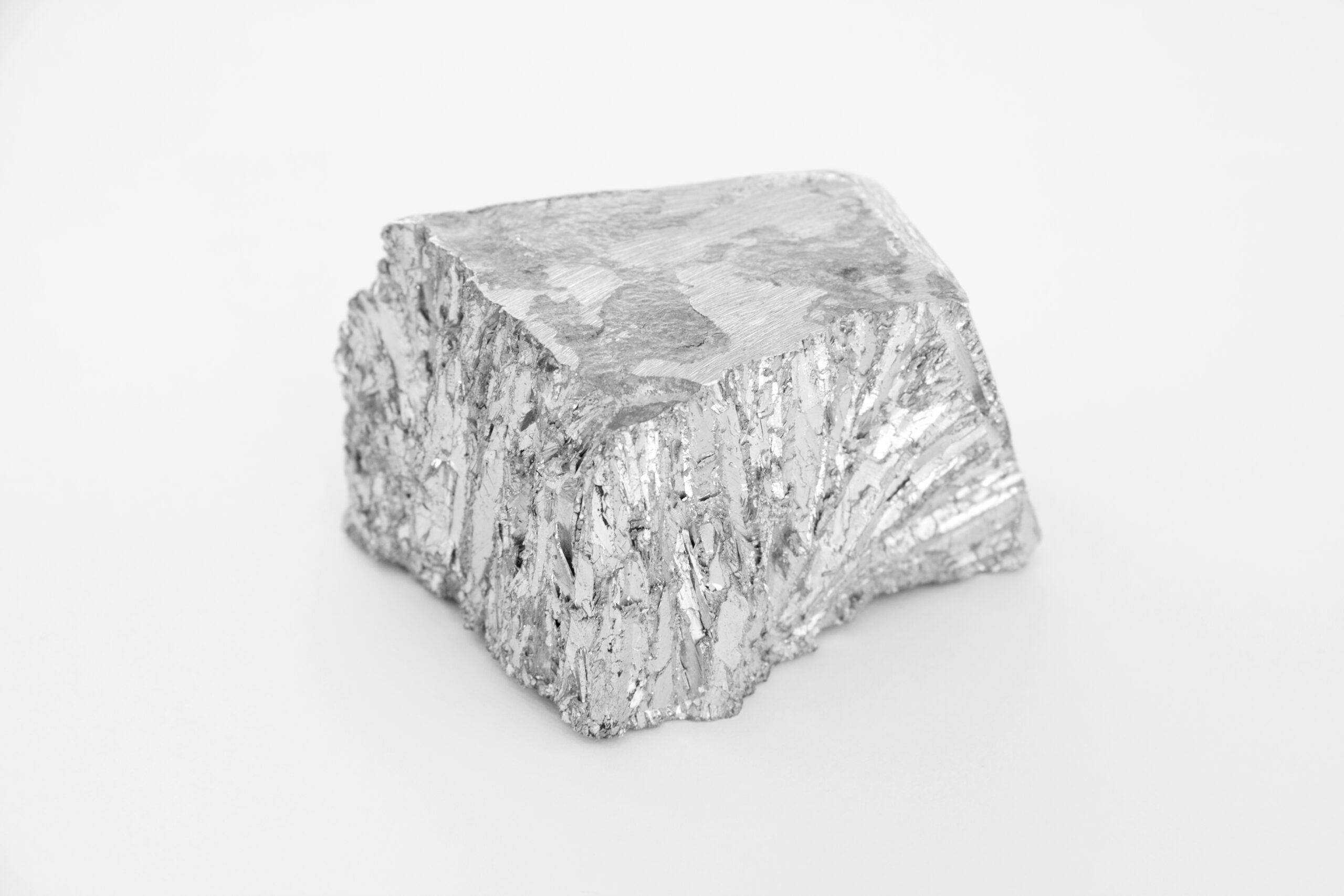Zinc is a chemical element with the symbol Zn and atomic number 30. Zinc is a slightly brittle metal at room temperature and has a blue-silvery appearance when oxidation is removed. It is the first element in group 12 of the periodic table. In some respects, zinc is chemically similar to magnesium: both elements exhibit only one normal oxidation state (+2), and the Zn2+ and Mg2+ ions are of similar size. Zinc is the 24th most abundant element in Earth’s crust and has five stable isotopes. The most common zinc ore is sphalerite (zinc blende), a zinc sulfide mineral. The largest workable lodes are in Australia, Asia, and the United States. Zinc is refined by froth flotation of the ore, roasting, and final extraction using electricity (electrowinning).
Brass, an alloy of copper and zinc in various proportions, was used as early as the third millennium BC in the Aegean, Iraq, the United Arab Emirates, Kalmykia, Turkmenistan and Georgia, and the second millennium BC in West India, Uzbekistan, Iran, Syria, Iraq, and Israel/Palestine. Zinc metal was not produced on a large scale until the 12th century in India, though it was known to the ancient Romans and Greeks. The mines of Rajasthan have given definite evidence of zinc production going back to the 6th century BC. To date, the oldest evidence of pure zinc comes from Zawar, in Rajasthan, as early as the 9th century AD when a distillation process was employed to make pure zinc. Alchemists burned zinc in air to form what they called “philosopher’s wool” or “white snow”.
The element was probably named by the alchemist Paracelsus after the German word Zinke (prong, tooth). German chemist Andreas Sigismund Marggraf is credited with discovering pure metallic zinc in 1746. Work by Luigi Galvani and Alessandro Volta uncovered the electrochemical properties of zinc by 1800. Corrosion-resistant zinc plating of iron (hot-dip galvanizing) is the major application for zinc. Other applications are in electrical batteries, small non-structural castings, and alloys such as brass. A variety of zinc compounds are commonly used, such as zinc carbonate and zinc gluconate (as dietary supplements), zinc chloride (in deodorants), zinc pyrithione (anti-dandruff shampoos), zinc sulfide (in luminescent paints), and dimethylzinc or diethylzinc in the organic laboratory.
Zinc is an essential mineral, including to prenatal and postnatal development. Zinc deficiency affects about two billion people in the developing world and is associated with many diseases. In children, deficiency causes growth retardation, delayed sexual maturation, infection susceptibility, and diarrhea. Enzymes with a zinc atom in the reactive center are widespread in biochemistry, such as alcohol dehydrogenase in humans.
Consumption of excess zinc may cause ataxia, lethargy, and copper deficiency.
Physical properties

Zinc is a bluish-white, lustrous, diamagnetic metal, though most common commercial grades of the metal have a dull finish. It is somewhat less dense than iron and has a hexagonal crystal structure, with a distorted form of hexagonal close packing, in which each atom has six nearest neighbors (at 265.9 pm) in its own plane and six others at a greater distance of 290.6 pm. The metal is hard and brittle at most temperatures but becomes malleable between 100 and 150 °C. Above 210 °C, the metal becomes brittle again and can be pulverized by beating. Zinc is a fair conductor of electricity. For a metal, zinc has relatively low melting (419.5 °C) and boiling points (907 °C). The melting point is the lowest of all the d-block metals aside from mercury and cadmium; for this, among other reasons, zinc, cadmium, and mercury are often not considered to be transition metals like the rest of the d-block metals.
Many alloys contain zinc, including brass. Other metals long known to form binary alloys with zinc are aluminium, antimony, bismuth, gold, iron, lead, mercury, silver, tin, magnesium, cobalt, nickel, tellurium, and sodium. Although neither zinc nor zirconium are ferromagnetic, their alloy ZrZn 2 exhibits ferromagnetism below 35 K.
A bar of zinc generates a characteristic sound when bent, similar to tin cry.
Occurrence

Zinc makes up about 75 ppm (0.0075%) of Earth’s crust, making it the 24th most abundant element. Soil contains zinc in 5–770 ppm with an average 64 ppm. Seawater has only 30 ppb and the atmosphere, 0.1–4 µg/m3. The element is normally found in association with other base metals such as copper and lead in ores. Zinc is a chalcophile, meaning the element is more likely to be found in minerals together with sulfur and other heavy chalcogens, rather than with the light chalcogen oxygen or with non-chalcogen electronegative elements such as the halogens. Sulfides formed as the crust solidified under the reducing conditions of the early Earth’s atmosphere. Sphalerite, which is a form of zinc sulfide, is the most heavily mined zinc-containing ore because its concentrate contains 60–62% zinc.
Other source minerals for zinc include smithsonite (zinc carbonate), hemimorphite (zinc silicate), wurtzite (another zinc sulfide), and sometimes hydrozincite (basic zinc carbonate). With the exception of wurtzite, all these other minerals were formed by weathering of the primordial zinc sulfides.
Identified world zinc resources total about 1.9–2.8 billion tonnes. Large deposits are in Australia, Canada and the United States, with the largest reserves in Iran. The most recent estimate of reserve base for zinc (meets specified minimum physical criteria related to current mining and production practices) was made in 2009 and calculated to be roughly 480 Mt. Zinc reserves, on the other hand, are geologically identified ore bodies whose suitability for recovery is economically based (location, grade, quality, and quantity) at the time of determination. Since exploration and mine development is an ongoing process, the amount of zinc reserves is not a fixed number and sustainability of zinc ore supplies cannot be judged by simply extrapolating the combined mine life of today’s zinc mines. This concept is well supported by data from the United States Geological Survey (USGS), which illustrates that although refined zinc production increased 80% between 1990 and 2010, the reserve lifetime for zinc has remained unchanged. About 346 million tonnes have been extracted throughout history to 2002, and scholars have estimated that about 109–305 million tonnes are in use.
Isotopes
Five stable isotopes of zinc occur in nature, with 64Zn being the most abundant isotope (49.17% natural abundance). The other isotopes found in nature are 66Zn (27.73%), 67Zn (4.04%), 68Zn (18.45%), and 70Zn (0.61%). The most abundant isotope 64Zn and the rare 70Zn are theoretically unstable on energetic grounds, though their predicted half-lives exceed 4.3×1018 years and 1.3×1016 years, meaning that their radioactivity could be ignored for practical purposes.
Several dozen radioisotopes have been characterized. 65Zn, which has a half-life of 243.66 days, is the least active radioisotope, followed by 72Zn with a half-life of 46.5 hours. Zinc has 10 nuclear isomers. 69mZn has the longest half-life, 13.76 h. The superscript m indicates a metastable isotope. The nucleus of a metastable isotope is in an excited state and will return to the ground state by emitting a photon in the form of a gamma ray. 61Zn has three excited metastable states and 73Zn has two. The isotopes 65Zn, 71Zn, 77Zn and 78Zn each have only one excited metastable state.
The most common decay mode of a radioisotope of zinc with a mass number lower than 66 is electron capture. The decay product resulting from electron capture is an isotope of copper.
Reactivity
Zinc has an electron configuration of [Ar]3d104s2 and is a member of the group 12 of the periodic table. It is a moderately reactive metal and strong reducing agent. The surface of the pure metal tarnishes quickly, eventually forming a protective passivating layer of the basic zinc carbonate, Zn5(OH) 6(CO3)2, by reaction with atmospheric carbon dioxide.
Zinc burns in air with a bright bluish-green flame, giving off fumes of zinc oxide. Zinc reacts readily with acids, alkalis and other non-metals. Extremely pure zinc reacts only slowly at room temperature with acids. Strong acids, such as hydrochloric or sulfuric acid, can remove the passivating layer and subsequent reaction with water releases hydrogen gas.
The chemistry of zinc is dominated by the +2 oxidation state. When compounds in this oxidation state are formed, the outer shell s electrons are lost, yielding a bare zinc ion with the electronic configuration [Ar]3d10. In aqueous solution an octahedral complex, [Zn(H2O)6]2+ is the predominant species. The volatilization of zinc in combination with zinc chloride at temperatures above 285 °C indicates the formation of Zn2Cl2, a zinc compound with a +1 oxidation state. No compounds of zinc in oxidation states other than +1 or +2 are known. Calculations indicate that a zinc compound with the oxidation state of +4 is unlikely to exist.
Zinc chemistry is similar to the chemistry of the late first-row transition metals, nickel and copper, though it has a filled d-shell and compounds are diamagnetic and mostly colorless. The ionic radii of zinc and magnesium happen to be nearly identical. Because of this some of the equivalent salts have the same crystal structure, and in other circumstances where ionic radius is a determining factor, the chemistry of zinc has much in common with that of magnesium. In other respects, there is little similarity with the late first-row transition metals. Zinc tends to form bonds with a greater degree of covalency and much more stable complexes with N- and S- donors. Complexes of zinc are mostly 4- or 6- coordinate although 5-coordinate complexes are known.
